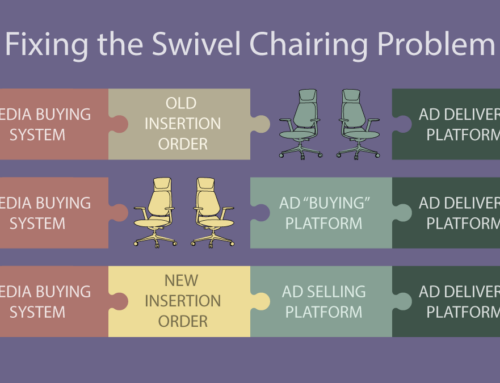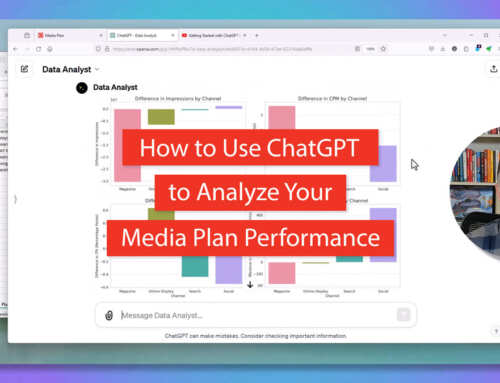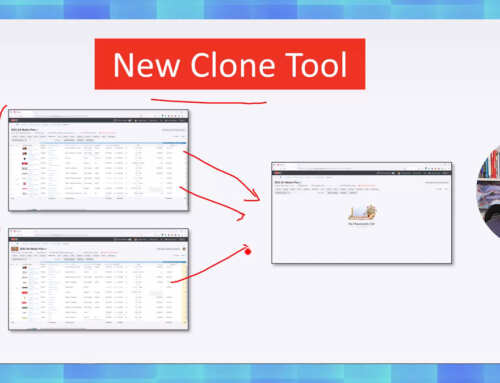With the rise of artificial intelligence (AI), you have a window of opportunity to win market share by leveraging AI to make your media planning more efficient and effective.
It’s clear AI can give you a competitive advantage. However, as recent AI failures with Google Bard and Microsoft Bing warn, you need to take great care in creating your AI.
A key factor in creating a smart, strong AI is feeding it good training data. Nutritious, healthy data. Not junk data.
In this article, you’ll learn how to source good data to train your media planning AI models.
What is Media Planning AI?
One of the main challenges of media planning is choosing the best media placements from among a virtually infinite set of advertising options.
Media Planning AI uses algorithms to analyze data and identify the best media placements to reach your target audience. It does this by scoring and ranking all the advertising options in the context of your particular media plan.
Using AI in media planning can:
- Streamline your workflow by automating repetitive decisions and keystrokes.
- Generate new ideas by recommending media options you may not have otherwise considered.
- Avoid embarrassing omissions by reminding you of the best performing media placements.
All this sounds great, right? But you’d be smart to be skeptical. That’s because many media agencies lack the data required to properly train an AI model.
Your Media Planning AI will only be as smart as its training data.
What is Training Data?
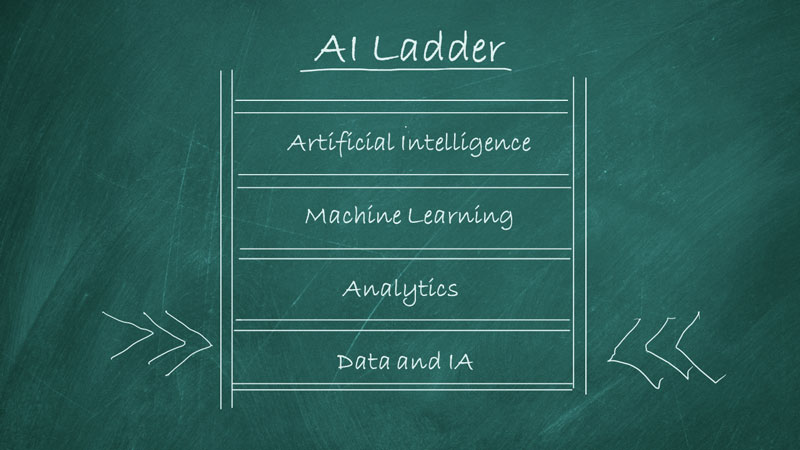
According to IBM’s AI Ladder, “AI requires machine learning; machine learning requires analytics; and analytics requires the right data and information architecture. In other words, there is no AI without IA (information architecture).”
Training data refers to the data you use to train your AI model. The data is ideally coded with media placement details and advertising outcomes, so your AI model can learn from these successes and failures and make accurate predictions on a new media plan.
In creating your Media Planning AI, training data is used to teach your model how to identify patterns and relationships in the media planning data, and to create an algorithm that can be used to make predictions or decisions when creating a new media plan.
The quality and quantity of the training data is critical to the performance and accuracy of your model. If your training data is biased or insufficient, your Media Planning AI will give you bad recommendations.
Your Training Data Needs Structure
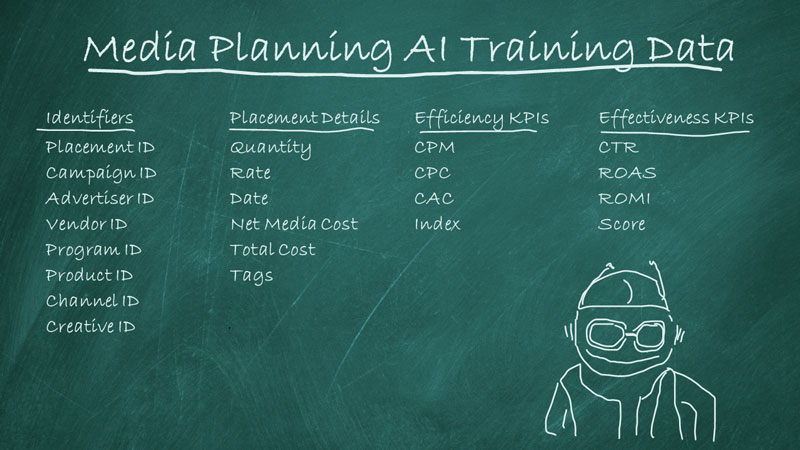
Imagine what would happen if you created a Media Planning AI model trained on a pile of random excel spreadsheets.
A pile of spreadsheets is hard to understand and full of inconsistencies and holes. AI is prone to “hallucinate” when it tries to fill gaps in missing information. Your AI might confidently present its hallucinations as fact which could trick you to make really bad decisions.
On the other hand, imagine what your AI could do if it were trained on solid media plan data.
What are Dependent and Independent Variables in AI?
In machine learning for AI, the dependent variable is the variable that we are trying to predict or estimate, while the independent variables are the variables that we use to make the prediction.
The accuracy of your AI model relies on consistent and accurate coding of these variables.
Identifiers as Independent Variables
One of most important types of independent variables are identifiers. As the name suggests, each identifier uniquely identifies the item involved in the data record.
Some examples of media plan identifiers are:
- Placement ID
- Campaign ID
- Advertiser ID
- Vendor ID
- Program ID
- Product ID
- Channel ID
- Creative ID
Identifiers are ideally integers or short codes (e.g., “100235”). It’s a bad idea to use text strings (e.g., “Procter & Gamble”) because strings are inconsistent and weigh down the training database. Don’t worry – you won’t have to look at a bunch of codes. When reporting, you can always look up the name and other information using the identifier.
You need a reliable system to generate and maintain these IDs for your internal data, such as placement ID, campaign ID, and creative ID. Your system needs to ensure these IDs are consistent from campaign to campaign and across your media teams. Otherwise, your Media Planning AI model will get confused during its training.
To leverage industry data, you’ll need access to a directory of industry standard identifiers, such as vendor ID, program ID, and product ID. If you’re not using the same IDs as others, there’s no way to leverage data outside your organization, nor measure your performance against industry benchmarks.
Placement Details as Independent Variables
Another rich source of predictive data are your media placement details, such as:
- Quantities
- Rates
- Dates
- Media Costs
Efficiency KPIs and Dependent Variables
If you want to predict the cost efficiency of media placements, you need to include cost efficiency KPIs as dependent variables in your training data.
Examples include:
- CPM – Cost per Thousand Impressions
- CPC – Cost Per Click
- CAC – Customer Acquisition Cost
- Cost Efficiency Index
This is just a small sample of the dozens of cost efficiency KPIs you may want to include in your training data.
Effectiveness KPIs as Dependent Variables
If you want to optimize the effectiveness of your advertising (who doesn’t?), you need to include effectiveness KPIs as dependent variables in your training data.
Examples include:
- CTR – Clickthrough Rate
- ROAS – Return on Ad Spend
- ROMI – Return on Marketing Investment
- Advertising Effectiveness Score
Effectiveness KPIs are notoriously difficult to calculate because they depend on attribution models and good integration. If you’ve gone through the pain to create these KPIs, you’ve got to include them in your training data!
How to Capture Media Planning Data
Capturing reliable and consistent media planning data is a daunting challenge for many advertisers and advertising agencies. That’s because placement-level media plans are incarcerated in spreadsheets. By the time they reach a real system, much of the predictive data has been lost along the way.
I’m not gonna lie… one reason I wrote this article is to brag about Bionic media planning software and its ability to source training data for your AI. I’m going to go out on a limb here and say that Bionic is probably the best software in the world for capturing clean media plan data. If you think otherwise, come at me bro. 😋
Seriously, Bionic can deliver all the data mentioned above plus a lot more.
If you’re not using Bionic, make sure your media planning software captures the data you need to train your AI models. Otherwise, you’ll be at a disadvantage when trying to compete with agencies using strong AI.
How to Deliver Training Data
Don’t forgot about data delivery. Your media plan data is useless if your AI cannot access it.
Your information architecture should include your AI data pipeline.
At the most basic level, your data pipeline delivers training data for up-front machine learning. At a more advanced level, your data pipeline delivers real-time feedback from users interacting with the AI in their daily workflow.
As you probably guessed, Bionic delivers media plan data in both batch data sets and real-time data flows. Bionic’s data pipeline is customizable to your AI’s needs.
No matter what system you use to capture your data, make sure it can also deliver your training data in the format and frequency you need to properly train your media planning AI models.
Your AI Success Depends on Training Data
Media planning AI can help you create effective campaigns and reach your target audience efficiently. However, to achieve the best results, it needs good training data. High-quality, representative data can help the AI make accurate predictions, scale effectively, and avoid bias. Without good training data, you risk missing out on valuable opportunities and falling behind the competition.
So, if you’re looking to leverage the power of media planning AI, be sure to invest in good training data. The right data can make all the difference between an embarrassing campaign and one that drives award-winning results.


